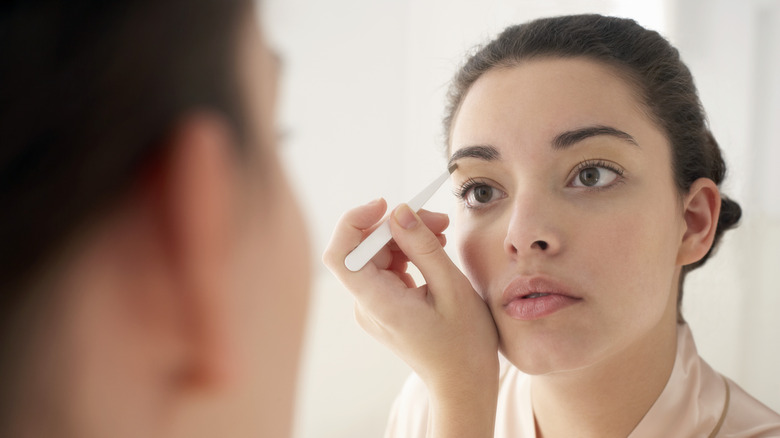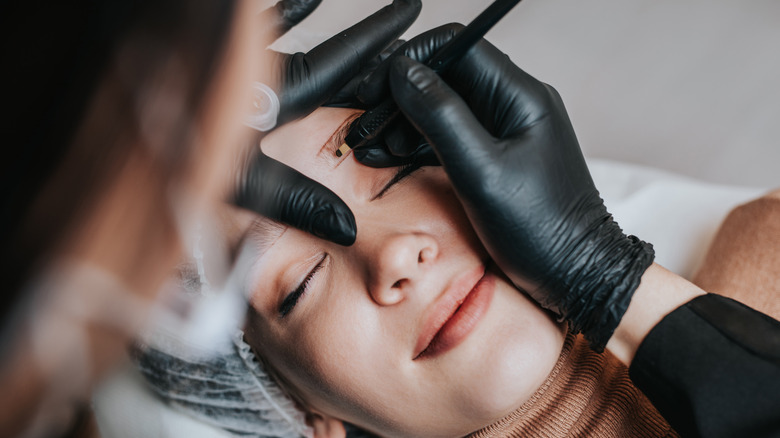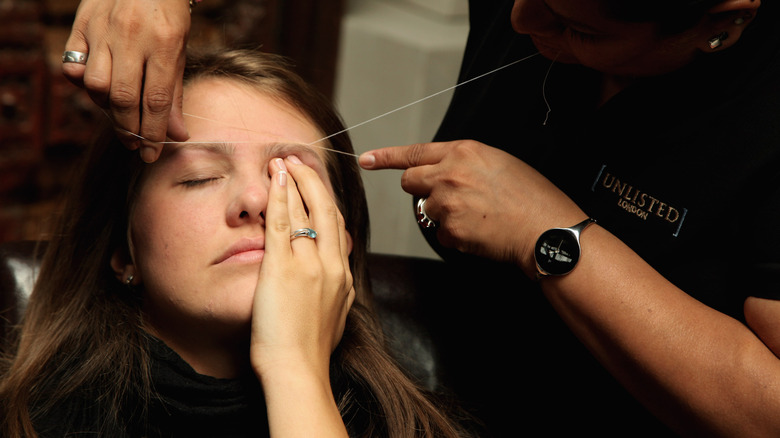Microblading Vs. Eyebrow Threading: What's The Difference?
Walking through a mall or along a busy street, the words "microblading" and "eyebrow threading" leap out from more than a few signs dangling in salon windows. Though they often appear side-by-side on cosmetic menus, these separate techniques have opposite aims. Microblading creates an illusion of thicker eyebrows, while eyebrow threading thins the brow line. Still, both treatments can help you gain the perfect eyebrow shape for your face or address changes in your eyebrows as you age.
Hair Essentials Salon Studios estimates microblading costs range from a low of $350 to a high of $800, depending on your zip code and the specialist. An appointment can take up to two and a half hours, as it involves carefully selecting brow color and shape, the website of Brow Society NYC, a specialist salon, explains. By contrast, the epilation technique known as "eyebrow threading" generally costs a more affordable $5 to $20 per session, each of which lasts roughly 20 minutes.
The need-to-know facts about each procedure follow.
Microblading can last up to 18 months
Microblading is a fairly new, minimally-invasive technique for making eyebrows look fuller. Many people describe it as a tattoo-like procedure. Microblading employs a hand tool with fine needles that is used to scratch the skin's surface and deposit pigment with thin, delicate strokes that mimic brow hairs, notes the salon Evertrue. Unlike tattooing, the color is only semi-permanent due to the use of pigment as opposed to ink. A natural look is achieved as the pigment fades from its darkest brown hue to a more natural shade that lasts up to 18 months and can be touched up annually. To make the color last longer, avoid sunlight and don't skimp on the sunscreen.
Microblading requires two sessions. The first is all about getting the basic shape down, while the follow up visit a few weeks later is intended to perfect the brow shape. The pigment will fade considerably within the first week as the eyebrows scab over and begin to peel. To avoid possible infection, you need to keep your brow clean and dry.
Microblading isn't for everyone, notes Baylor College of Medicine, including those who are pregnant or nursing. Those who have undergone chemo, radiation, or have taken retinoids like Accutane in the past year should also give the procedure a miss, as well as people who are on blood thinners or have red dye allergies. Since microblading can cause scarring, those who are prone to keloids should also avoid it. Check with your doctor before booking the procedure.
Eyebrow threading has been around for centuries
Threading originated in Southeast Asia hundreds of years ago and circled the globe from there, according to Byrdie. The name clues you into how the technique is performed. The specialist manipulates a piece of cotton thread, pulling out facial hairs either one by one or in an entire line.
Eyebrow threading, which does not require chemicals or wax, results in a well-defined brow with clean lines that unfortunately lasts only temporarily, since plucked hair usually grows back in three to four weeks. Before and after your appointment, you might try washing with cold water to help prevent redness, pain, and possible infection, though a skilled threader will likely swab your brows with alcohol both before and after the procedure. While it should not damage delicate skin, some clients experience minor bleeding or peeling. Most people can dodge these side effects by following the pre-treatment recommendation to avoid any product that makes your skin more sensitive. In particular, retinol-based creams and lotions should not be used for a full week before threading.
Post-treatment, a few simple safety measures will help you avoid infections and breakouts, advises Cleveland Clinic. First and foremost, don't touch your brow in those first few days post-threading. You'll also want to avoid going for a dip in a swimming pool or hot tub while healing, especially outdoors as sunlight can be harsh on your still-sensitive skin. Finally, learn to love your natural face, as makeup will clog your still-open hair follicles, leading to skin issues.


